
Imagine if we could see, touch, and hear viruses without the use of specialised scientific equipment?
Artists Dr Erica Tandori and Stuart Favilla plunge us into a virus’s world with Sensory Science Exhibition. Make your own virus model with couscous and chicken wire, and listen to sounds inspired by the activity of viruses.
Activities are informed by the research conducted in the Rossjohn laboratory at the Monash Biomedicine Discovery Institute, and designed to be easily accessed by everyone, with instructions for people with low vision.
Image (left): Model of HIV virus created by Dr Tandori.
Make an HIV couscous model
Follow along with Dr Tandori in this short video to make your very own HIV virus model. To help you along the way download the written instructions and the HIV capsid template.
ASMR Couscous project
This is a 3D model making workshop with Rossjohn Labs artist in residence Dr Erica Tandori recorded for 2020 National Science Week. The workshop explores how to build a high resolution model of the HIV Capsid molecule without a 3D printer just using chicken wire and couscous. The workshop is presented in ASMR for audiences with low vision and blindness.
Virus Sounds – Synonymous and Non-synonymous Harmonic Fields
If we could hear viruses, what would they sound like?
Synonymous and Non-synonymous Harmonic Fields was composed by Stuart Favilla for 2020 National Science Week, realised for modular synthesiser. In this work, the virus is represented by self-oscillating, generative music synthesis. The piece brings Stuart’s own human bioelectric signals into the modular synthesiser sometimes resulting in a large structural change or new zoonotic musical strain. The intention of the work is to reflect current theories behind the origin and evolution of viruses including COVI2-SARS and HIV. Full description of the work.
The HIV Capsid Data Projection Project
It’s going viral on YouTube!
This HIV Capsid data projection project brings 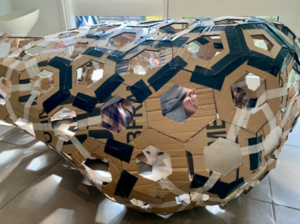 multi-sensory science to a whole new level. The sculpture stands at approximately 1.6 metres high and 1.5 metres at its widest point, big enough for a teenager and a cat to climb inside!
multi-sensory science to a whole new level. The sculpture stands at approximately 1.6 metres high and 1.5 metres at its widest point, big enough for a teenager and a cat to climb inside!
Created with cardboard hexagonal shapes and smothered in millions of tiny foam balls, the life size HIV Capsid sculpture becomes a three-dimensional projection screen displaying computerised viral mutating lifeforms.
Watching the HIV Capsid dance in time to the music brings with it the effect of ‘cortical completion’, where the data movements seemingly dance in time to the driving beat. In rhythmical syncopation, music becomes the dominant sensory channel. During those moments 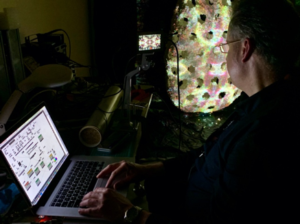 and gestures, identifiable features in sound become ‘attention grabbing’ and the mesmerising (confusing and unidentifiable) visuals then suddenly synchronise and take form in the brain, creating a whole new sensory realm of visual and aural perceptions.
and gestures, identifiable features in sound become ‘attention grabbing’ and the mesmerising (confusing and unidentifiable) visuals then suddenly synchronise and take form in the brain, creating a whole new sensory realm of visual and aural perceptions.
In the context of Possible Impossibles our giant 3D Interactive data projecting HIV Capsid has much to offer, but perhaps the obvious one is “the best way to take your virus out on the dance floor!”
Sculpture: Dr Erica Tandori. Music: Stu Favilla.
Sensory Science Exhibition
Enjoy this picture gallery from the Sensory Science Exhibition created by Dr Erica Tandori at Parliament House Melbourne as part of the ‘Extrasensory’ National Science Week event in 2019.
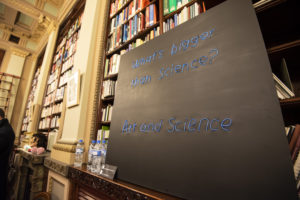 |
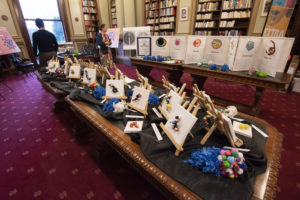 |
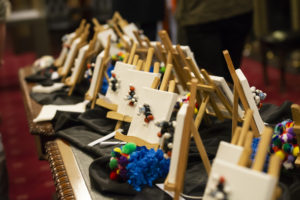 |
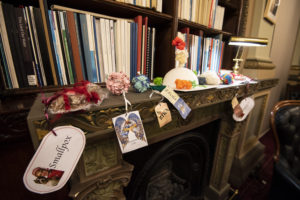 |
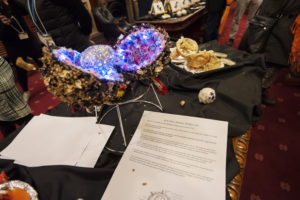 |
 |
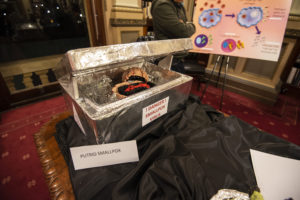 |
 |
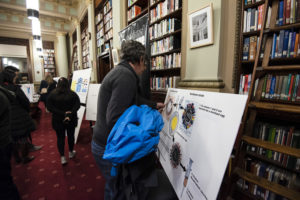 |
About the artists
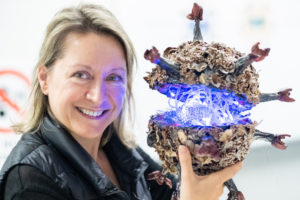 Dr Erica Tandori is a legally-blind artist, academic and public speaker, and is artist-in-residence within the lab of ARC Laureate fellow, Prof. Jamie Rossjohn, in the ARC Centre of Excellence in Advanced Molecular Imaging at the Monash Biomedicine Discovery Institute. Dr Tandori. She has a PhD in visual art and ophthalmology, in which she used art to articulate the processes of her own vision loss caused by juvenile macular degeneration. Since being diagnosed with the degenerative disease in her first year of art school, Erica has devoted her art-making and research to an examination of what it means to experience living with vision loss.
Dr Erica Tandori is a legally-blind artist, academic and public speaker, and is artist-in-residence within the lab of ARC Laureate fellow, Prof. Jamie Rossjohn, in the ARC Centre of Excellence in Advanced Molecular Imaging at the Monash Biomedicine Discovery Institute. Dr Tandori. She has a PhD in visual art and ophthalmology, in which she used art to articulate the processes of her own vision loss caused by juvenile macular degeneration. Since being diagnosed with the degenerative disease in her first year of art school, Erica has devoted her art-making and research to an examination of what it means to experience living with vision loss.
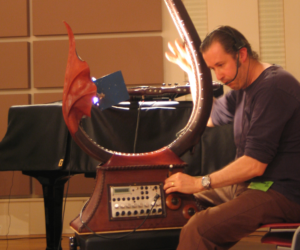
Stuart Favilla is a lecturer and researcher in the School of Design at Swinburne University. His research interests span human computer interactions, ultrasound, mood disorders, and aged care. Stuart specialises in synthesiser/computer music performance and works as a composer/producer and musical director for film, theatre and festivals.
More
Possible Impossibles interviewed Dr Erica Tandori and Stuart Favilla about what impossible research they are conducting, and what’s next for their research fields.
Read their responses here:
Possible Impossibles Q&A with Dr Erica Tandori
Possible Impossibles Q&A with Stu Favilla
